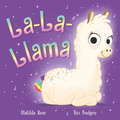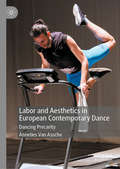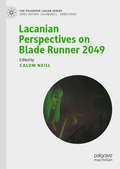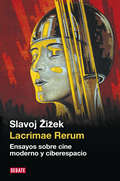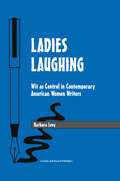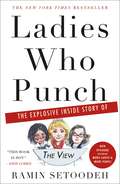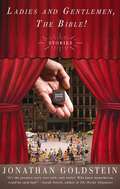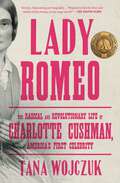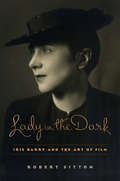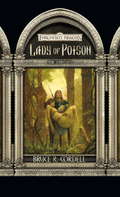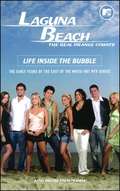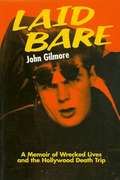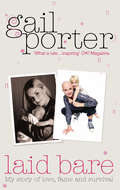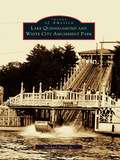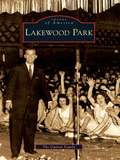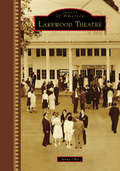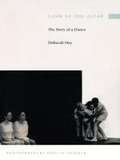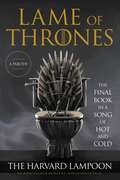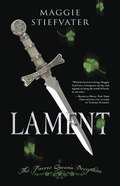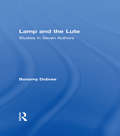- Table View
- List View
La zapatera prodigiosa
by Federico García LorcaUna pareja despareja cobra vida en esta farsa plena de simbolismos y matices. Un pasaje creativo cita una historia recurrente en la literatura universal, aunque abordada con la particular óptica del teatro español. Las obras de Federico García Lorca alcanzan cada día mayor difusión y prestigio. Ello evidencia los valores sustantivos y perdurables de las mismas, independientemente de la atención multitudinaria que se vertió sobre la gloriosa figura de su autor a raíz de su muerte trágica. De esta suerte, y no obstante hallarse en constante reimpresión los tomos de sus Obras completas, sus títulos más significativos están accesibles en ediciones sueltas. La zapatera prodigiosa, contrariamente a Yerma, viene a ser un intermedio, un ""divertimento"", pero de la más fina calidad. Corresponde a la modalidad de lo que pudiéramos llamar ""teatro de cámara"", y en efecto, su origen fue éste, ya que se estrenó en el club ""Anfistora"" de Madrid, en 1930.
La-La-Llama (The Magic Pet Shop #2)
by Matilda RosePrince Leo is a shy, quiet prince. But Mrs Paws has just the pet for him . . . La-La-Llama: a magical llama with the power of song!There is going to be a talent competition in Twinkleton-Under-Beanstalk. All Prince Leo's friends are entering - and they want Leo to join them. Prince Leo doesn't want to say no . . . but he's terrified of performing in front of so many people! Can Leo overcome his nerves and find his voice . . . with some help from La-la-llama?From the creators of Pugicorn comes a magical and fun-filled story with a super sparkly glitter cover! Discover other books in the Magic Pet Shop series:PugicornPugicorn and the Christmas WishStarwhalPandarina
Labor and Aesthetics in European Contemporary Dance: Dancing Precarity
by Annelies Van AsscheThis transdisciplinary study scientifically reports the way the established contemporary dance sector in Europe operates from a micro-perspective. It provides a dance scholarly and sociological interpretation of its mechanisms by coupling qualitative data (interview material, observations, logbooks, and dance performances) to theoretical insights. The book uncovers the sometimes contradicting mechanisms related to the precarious project-oriented labor and art market that determine the working and living conditions of contemporary dance artists in Europe’s dance capitals Brussels and Berlin. In addition, it examines how these working and living conditions affect the work process and outcome. From a sociological perspective, the book engages with the relevant contemporary social issue of precarity and this within the much-at-risk professional group of contemporary dance artists. In this regard, the research brings novelty within the subject area, particularly by employing a unique methodological approach. Although the research is initially set up in a specific geographical context and within a specific research population, the book offers insights into issues that affect our neoliberal society at large. The research findings show potential to make a relevant contribution with regards to precarity within dance studies and performance studies, but also labor studies and cultural sociology.
Lacan, Psychoanalysis, and Comedy
by Patricia Gherovici Manya SteinkolerThis collection of essays explores laughter, humor, and the comic from a psychoanalytic perspective. Edited by two leading practicing psychoanalysts and with original contributions from Lacanian practitioners and scholars, this cutting-edge volume proposes a paradigm swerve, a Freudian slip on a banana peel. Psychoanalysis has long been associated with tragedy and there is a strong warrant to take up comedy as a more productive model for psychoanalytic practice and critique. Jokes and the comic have not received nearly as much consideration as they deserve given the fundamental role they play in our psychic lives and the way they unite the fields of aesthetics, literature, and psychoanalysis. Lacan, Psychoanalysis and Comedy addresses this lack and opens up the discussion.
Lacanian Perspectives on Blade Runner 2049 (The Palgrave Lacan Series)
by Calum NeillThis book provides a collection of Lacanian responses to Denis Villeneuve’s Blade Runner 2049 from leading theorists in the field. Like Ridley Scott’s original Blade Runner film, its sequel is now poised to provoke philosophical and psychoanalytic arguments, and to provide illustrations and inspiration for questions of being and the self, for belief and knowledge, the human and the post-human, amongst others. This volume forms the vanguard of responses from a Lacanian perspective, satisfying the hunger to extend the theoretical considerations of the first film in the various new directions the second film invites. Here, the contributors revisit the implications of the human-replicant relationship but move beyond this to consider issues of ideology, politics, and spectatorship. This exciting collection will appeal to an educated film going public, in addition to students and scholars of Lacanian psychoanalysis, psychoanalytic theory, cultural studies, film theory, philosophy and applied psychoanalysis.
Lacombe Lucien: The Screenplay
by Patrick Modiano Sabine Destrèe Louis MallePatrick Modiano and Louis Malle's screenplay for the Oscar-nominated film tells a powerful story set in World War II France of a seventeen-year-old boy who allies himself with collaborators, only to fall in love with a Jewish girl <P> This early work by the Nobel Prize winner Patrick Modiano relates the story of Lucien Lacombe: a poor boy in Nazi-occupied France who, rebuffed in his efforts to enter the Resistance for a taste of war, becomes a member of a sordid, pathetic group of Fascist collaborators who join the Gestapo in preying upon their countrymen. Lucien encounters the Horns, a Jewish family from Paris hiding in his provincial town. Inevitably, he must choose between the coarse appeal of violence and his emerging feelings of tenderness for the family's daughter, France. Amid the excesses brought on by the impending collapse of the Nazi occupation, Lucien and France come to live out an improbable idyll. This classic is an essential read for students and film lovers alike.
Lacrimae rerum: Ensayos sobre cine y ciberespacio
by Slavoj ZizekConsiderado el «séptimo arte», el cine ha sido y sigue siendo uno de los medios de comunicación de masas más importantes. <P><P>Desde la primera función en el sótano del Grand Café des Capucines de París hace algo más de cien años, hasta las grandes superproducciones de Hollywood que dominan las pantallas del mundo, el cine ha sido técnica e industria, entretenimiento y vehículo de expresión de ideas y sentimientos. <P><P>Partiendo de estas consideraciones y estudiando la labor de reconocidos directores, el filósofo y psicoanalista Slavoj Zizek, profundo conocedor del universo cinematográfico y de la influencia de los medios de comunicación en la sociedad contemporánea, reflexiona sobre los temas principales de estos maestros y sus motivaciones a la hora de situarse detrás de la cámara. <P><P>De la imposibilidad de hacer remakes de las películas de Alfred Hitchcock al pesimismo en la obra de Krzysztof Kieslowski; de la imagen de la mujer, la irracionalidad y la angustia en los trabajos de Andrei Tarkovski y David Lynch a la posibilidad imaginaria o real de desplazarse a través del tiempo y el espacio como los personajes de Matrix, Zizek desarrolla su imaginación crítica y su agudo sentido literario para atrapar al lector con imágenes, ideas y revelaciones que sorprenderán no solo a los buenos aficionados al cine, sino también a todos aquellos que deseen acercarse a los clásicos de la pantalla de la mano de este original y provocador filósofo.
Ladies First: Revelations of a Strong Woman
by Queen Latifah Karen HunterAutobiography of a rap star.
Ladies Laughing: Wit as Control in Contemporary American Women Writers (Studies In Humor And Gender Ser. #Vol. 3)
by Barbara LevyThis engaging and accessible book examines the world of seven contemporary, popular American women writers and their individual use of wit as a subtle and effective strategy to engage, or "control", the reader. A chapter is devoted to each of the seven writers - Lisa Alther, Rita Mae Brown, Nora Ephron, Shirley Jackson, Alison Lurier, Grace Paley, and Anne Tyler - and discusses their writings and their use of wit in the context of their lives. An opening chapter frames wit and control in psychological realities, and a concluding chapter summarizes the power of wit. A bibliography of the writers' works is also included, making this an ideal introduction and companion to these writers and their works.
Ladies Who Punch: The Explosive Inside Story of "The View"
by Ramin SetoodehTHE INSTANT NEW YORK TIMES AND WALL STREET JOURNAL BESTSELLER <P><P>Like Fire & Fury, the gossipy real-life soap opera behind a serious show. When Barbara Walters launched The View, network executives told her that hosting it would tarnish her reputation. Instead, within ten years, she’d revolutionized morning TV and made household names of her co-hosts: Joy Behar, Star Jones, Meredith Vieira and Elisabeth Hasselbeck. But the daily chatfest didn’t just comment on the news. It became the news. And the headlines barely scratched the surface. <P><P>Based on unprecedented access, including stunning interviews with nearly every host, award-winning journalist Ramin Setoodeh takes you backstage where the stars really spoke their minds. Here's the full story of how Star, then Rosie, then Whoopi tried to take over the show, while Barbara struggled to maintain control of it all, a modern-day Lear with her media-savvy daughters. <P><P>You'll read about how so many co-hosts had a tough time fitting in, suffered humiliations at the table, then pushed themselves away, feeling betrayed—one nearly quitting during a commercial. Meanwhile, the director was being driven insane, especially by Rosie. <P><P>Setoodeh uncovers the truth about Star’s weight loss and wedding madness. Rosie’s feud with Trump. Whoopi’s toxic relationship with Rosie. Barbara’s difficulty stepping away. Plus, all the unseen hugs, snubs, tears—and one dead rodent. <P><P>Ladies Who Punch shows why The View can be mimicked and mocked, but it can never be matched. <P><b>A New York Times Bestseller</b>
Ladies and Gentlemen, the Bible!
by Jonathan GoldsteinA hilarious re-imagining of the heroes of the Old Testament for a modern world-and the neurotic, demanding reader. In the beginning... there was humor. Sure, it's the foundation for much of Western morality and the cornerstone of world literature. But let's face it: the Bible always needed punching up. Plus, it raised quite a few questions that a modern world refuses to ignore any longer: wouldn't it be boring to live inside a whale? How did Joseph explain Mary's pregnancy to the guys at work? Who exactly was the megalomaniacal foreman who oversaw the construction of the Tower of Babel? And honestly, what was Cain's problem? In Ladies and Gentlemen, the Bible!, Jonathan Goldstein re-imagines and recasts the Bible's greatest heroes with depth, wit, and snappy dialogue. This is the Bible populated by angry loners, hypochondriacs, and reluctant prophets who fear for their sanity. Basically, a Bible that readers can finally, genuinely relate to.
Lady Romeo: The Radical and Revolutionary Life of Charlotte Cushman, America's First Celebrity
by Tana WojczukFor fans of Book of Ages and American Eve, this illuminating and enthralling biography of 19th-century queer actress Charlotte Cushman portrays her radical lifestyle that riveted New York City and made headlines across America. From the very beginning, she was a radical. At age nineteen, Charlotte Cushman, America&’s beloved actress and the country&’s first true celebrity, left her life—and countless suitors—behind to make it as a Shakespearean actress. After revolutionizing the role of Lady Macbeth in front of many adoring fans, she went on the road, performing in cities across a dividing America and building her fame. She was everywhere. And yet, her name has faded in the shadows of history. Now, for the first time in decades, Cushman&’s story comes to full and brilliant life in this definitive, exhilarating, and enlightening biography of the 19th-century icon. With rarely seen letters, Wojczuk reconstructs the formative years of Cushman&’s life, set against the excitement and drama of New York City in the 1800s, featuring a cast of luminaries and revolutionaries that changed the cultural landscape of America forever. A vivid portrait of an astonishing and uniquely American life, Lady Romeo reveals one of the most remarkable women in United States history, and restores her to the center stage where she belongs.
Lady in the Dark: Iris Barry and the Art of Film
by Robert SittonIris Barry (1895–1969) was a pivotal modern figure and one of the first intellectuals to treat film as an art form, appreciating its far-reaching, transformative power. Although she had the bearing of an aristocrat, she was the self-educated daughter of a brass founder and a palm-reader from the Isle of Man. An aspiring poet, Barry attracted the attention of Ezra Pound and joined a demimonde of Bloomsbury figures, including Ford Maddox Ford, T. S. Eliot, Arthur Waley, Edith Sitwell, and William Butler Yeats. She fell in love with Pound's eccentric fellow Vorticist, Wyndham Lewis, and had two children by him.In London, Barry pursued a career as a novelist, biographer, and critic of motion pictures. In America, she joined the modernist Askew Salon, where she met Alfred Barr, director of the new Museum of Modern Art. There she founded the museum's film department and became its first curator, assuring film's critical legitimacy. She convinced powerful Hollywood figures to submit their work for exhibition, creating a new respect for film and prompting the founding of the International Federation of Film Archives. Barry continued to augment MoMA's film library until World War II, when she joined the Office of Strategic Services to develop pro-American films with Orson Welles, Walt Disney, John Huston, and Frank Capra. Yet despite her patriotic efforts, Barry's "foreignness" and association with such filmmakers as Luis Buñuel made her the target of an anticommunist witch hunt. She eventually left for France and died in obscurity. Drawing on letters, memorabilia, and other documentary sources, Robert Sitton reconstructs Barry's phenomenal life and work while recasting the political involvement of artistic institutions in the twentieth century.
Lady of Poison (Forgotten Realms: Priests #1)
by Bruce R. CordellCordell pens the first title in a new Forgotten Realms series focusing specifically on priests, the popular D&D game's iconic class also known as clerics. Each title will chronicle priests loyal to a different deity in the Forgotten Realms pantheon.
Laguna Beach: Life Inside the Bubble
by Kathy Passero Beth EfranWelcome to Paradise. Otherwise known as Laguna Beach. You've seen the backstabbing, betrayal, and small-town gossip set against the wealthy beachside paradise that is Laguna Beach, California. You've seen hook-ups, break-ups, screw-ups and make-ups -- and all just during two years of school. Now find out what life was like for the stars of Laguna Beach: The Real Orange County before the hit MTV series. Think you know Kristin, Talan, Stephen, Taylor, LC, and their friends? Think again. You'll find out: How and when Stephen and LC hooked up and the "drama" that followed How Stephen and Kristin started dating Why Trey got interested in activism and politics How Lo learns that it's better to go to a party in Laguna Beach than to give one Talan's life as a pre-teen football star Taylor and Alex M.'s early fights over boys What their lives were like growing up What they all thought of each other when they first met, how their friendships formed, and more Packed with tons of exclusive material from embarrassing baby photos to first-kiss stories, here is everything you ever wanted to know about Laguna Beach's teen royalty.
Laid Back in Washington
by Art Buchwald"Who is that man in the white hat on the palomino horse riding down Pennsylvania Avenue?" the lady asked. "That's Art Buchwald, who's come to town to help rid President Reagan of fraud, waste and corruption in the government." "What's that on his hip?" "That's a Smith-Remington typewriter. Buchwald has the reputation for being the fastest hunt-and-peck man in the East. I've seen him hit three congressmen with one paragraph, at 100 yards." "He sure looks laid back in the saddle." "Don't let that trick you. He's picked up the California style ever since the Reagans moved into the White House. Nobody messes with him when he's looking for a column. He's taken on six Presidents, eight Vice Presidents, the FBI, the CIA, and the entire Department of Energy in his time." "He looks awfully fat for a gunslinger." "That's what fools most people. Under that soft underbelly is a thin hostile man screaming to get out." "Where's he going now?" "Heaven only knows, but I would hate to be anywhere near him when he pulls out his Smith-Remington and starts shooting up the town." "How can he tell the bad guys from the good guys?" "He works under the assumption that there( are no bad guys in Washington-only good guys doing bad things." "I guess we can all sleep better knowing he's here." "You can say that again. He's the only one who can save us from ourselves." "Oh my God, he just fell off his horse." "That's just a trick of his so no one in Washington will take him seriously." Following in the profoundly unserious spirit of Down the Seine and Up the Potomac and The Buchzvald Stops Here, Laid Back in Washington leaves no turn unstoned, but no feelings hurt for long. In this dazzling yet dizzy portrait of the new Washington, Art Buchwald not only reveals himself as the master chronicler of our leaders' foibles, but as a sophisticated wit in the elegant tradition of Oscar Wilde and Snoopy.
Laid Bare: A Memoir of Wrecked Lives and the Hollywood Death Trip
by John GilmoreA powerful chronicler of the American Nightmare through his gripping examinations of near-mythic Southern California murders (the Black Dahlia, Tate-La Bianca), John Gilmore now draws upon his personal experiences to turn his sights on our morbid obsession with Celebrity and the ruinous price it extracts from those who would pursue it. With caustic clarity and 20/20 hindsight, Gilmore unstintingly recounts his relationships with the likes of Janis Joplin, Jack Nicholson, Dennis Hopper, Jane Fonda, Jean Seberg and Lenny Bruce on the way up and at the peaks of their notoriety. In baring his role in James Dean's attempts to push the bounds of sexual experimentation, Gilmore explores the actor's legendary fascination with speed and death. With hip, vivid prose, Gilmore describes his illuminating and often haunting first-hand encounters with Hank Williams, Ed Wood, Jr., Briggite Bardot, Sal Mineo, Eartha Kitt, Charles Manson, Jayne Mansfield, Vampira, Steve McQueen and many other denizens of the 20th century's dubious Pantheon.
Laid Bare: My story of love, fame and survival
by Gail PorterGail Porter burst on to our TV screens in the late 90s presenting The Movie Chart Show, Alive and Kicking and Top of the Pops. Bright, sparky and beautiful she soon attracted an entirely different audience, posing for a number of men's magazines and rapidly becoming the pin-up of the lad-mag generation. FHM, in a now famous stunt, even projected her naked form on to the Houses of Parliament. But beneath her cheery public façade, Gail was struggling with anorexia and bi-polar disorder. After nine years of extreme dieting, she collapsed and through sheer determination forced herself to begin eating properly again. Having been told she would never be able to conceive, her new healthier lifestyle led to a much desired pregnancy by her then husband, Toploader guitarist Dan Hipgrave. But the intense pressures of juggling motherhood with her career, led to crippling post-natal depression and precipitated the breakdown of her marriage. Overwhelmed by single motherhood, one day after dropping her daughter Honey off at nursery, she took an overdose and her world very publicly began to unravel.But Gail's ability to stay afloat as her life crumbled in the public spotlight made her an icon all over again for a new audience of ordinary women who recognised her pain. She refused to hide-away as stress-induced alopecia caused her to loose her hair, famously appearing at a charity event sporting a startling pink Mohican. Her stunning features and her unwillingness to wear a wig to hide her bald head have made her a contemporary icon.But despite all her troubles, Gail remains upbeat and positive. She has become a role model for coming through it all as a good mother and a working woman unbowed. As iconic as Jordan, smart as Billie and as wild as Kerry, Gail Porter has written her autobiography herself - a raw, honest account of her own troubled life and the world of celebrity we now live in.
Lake Quinsigamond and White City Amusement Park (Images of America)
by Michael Perna Jr.In the 1800s and well into the 1900s, the area around Lake Quinsigamond, in Shrewsbury and Worcester, was one huge summer resort. Hotels, ethnic and social clubs, boat clubs, a horse racing track, picnic grounds, and two amusement parks, Lincoln Park and White City Park, lined the shore. Steamboats and smaller steam launches transported tourists to the area. Canoes, rowboats, sailboats, and motorboats crowded the lake on weekends. Crew boat regattas, which started in the 1850s, continue to this day. Lake Quinsigamond and White City Amusement Park lets readers experience the attractions, such as the shoot the chutes and White City roller coaster, and enjoy the fun atmosphere during those long-ago summers.
Lakewood Park (Images of America)
by The Guinan FamilySituated in the coal regions of northeast Pennsylvania, Lakewood Park was established in 1916 by the Guinan family as a place to bathe, picnic, and camp. It became known as a nature retreat for the nearby miners and their families, and it developed into the destination for swimming, amusement rides, skating, big band dances, boxing matches, ethnic celebrations, summer stock plays, and political banquets. The park boasted a 150-yard cement pool, hand-carved Spillman carousel, and grand ballroom. It was the host of the longest-running ethnic festival in Pennsylvania, Lithuanian Day, from 1914 to 1984. Using vintage images, Lakewood Park recalls the various festivals and celebrations, amusements rides, and celebrity performers, such as Dick Clark and Doris Day, that made the park an entertainment mecca for 68 years.
Lakewood Theatre (Images of America)
by Jenny ObyBeginning as a humble vaudeville hall in the Skowhegan-Madison trolley park, Lakewood Theatre has graced the southwestern shore of Lake Wesserunsett in Madison, Maine, since the turn of the 20th century. Under the masterful guidance of Herbert L. Swett, a Bangor native and Bowdoin graduate, Lakewood eventually developed into a nationally renowned playhouse that was called the “Broadway in Maine” by the New York Times in its heyday, from 1925 until World War II. In the years following the war, Lakewood was operated by Swett’s heirs and became a virtual who’s who of both Broadway and Hollywood, until it nearly went dark in the early 1980s. Operating today as a nonprofit community theater, Lakewood is the official state theater of Maine and the oldest continually running summer theater in the country.
Lamb at the Altar: The Story of a Dance
by Deborah Hay"The intention of my work is to dislodge assumptions about the fixity of the three-dimensional body."--Deborah HayHer movements are uncharacteristic, her words subversive, her dances unlike anything done before--and this is the story of how it all works. A founding member of the famed Judson Dance Theater and a past performer in the Merce Cunningham Dance Company, Deborah Hay is well known for choreographing works using large groups of trained and untrained dancers whose surprising combinations test the limits of the art. Lamb at the Altar is Hay's account of a four-month seminar on movement and performance held in Austin, Texas, in 1991. There, forty-four trained and untrained dancers became the human laboratory for Hay's creation of the dance Lamb, lamb, lamb . . . , a work that she later distilled into an evening-length solo piece, Lamb at the Altar. In her book, in part a reflection on her life as a dancer and choreographer, Hay tells how this dance came to be. She includes a movement libretto (a prose dance score) and numerous photographs by Phyllis Liedeker documenting the dance's four-month emergence.In an original style that has marked her teaching and writing, Hay describes her thoughts as the dance progresses, commenting on the process and on the work itself, and ultimately creating a remarkable document on the movements--precise and mysterious, mental and physical--that go into the making of a dance. Having replaced traditional movement technique with a form she calls a performance meditation practice, Hay describes how dance is enlivened, as is each living moment, by the perception of dying and then involves a freeing of this perception from emotional, psychological, clinical, and cultural attitudes into movement. Lamb at the Altar tells the story of this process as specifically practiced in the creation of a single piece.
Lame of Thrones: The Final Book in a Song of Hot and Cold
by The Harvard LampoonFrom Harvard's legendary humor publication comes an outrageous, uproariously funny parody of Game of Thrones, in the tradition of their previous bestselling parody book classics Bored of the Rings, Nightlight, and The Hunger Pains.An affectionate but take-no-prisoners send-up of the massive literary and television franchise, Lame of Thrones offers fans a way of reentering the fictional world they have come to love and merrily explodes all of its conventions -- as well as their expectations of the characters -- to hilarious ends. It may even leave you more satisfied than the actual TV ending of Game of Thrones. In fact, if it doesn't the Lampoon has really dropped the ball. Lame of Thrones will take you to Westopolis, where several extremely attractive egomaniacs are vying to be ruler of the realm and sit on the Pointy Chair. Our hero Jon Dough was a likely bet, but his untimely murder at the hands of his own men of the Night's Crotch has made that seem less likely. Will Dragon Queen Dennys Grandslam escape from her Clothkhaki captors and return to conquer the world? Or will she just get left in the desert counting grains of sand for the rest of the book? And what about Jon Dough's siblings? Will they be mentioned? Probably? Almost definitely, yes? It would be weird if they weren't prominent characters in the book, you say?To find out, read the book you wish George R.R. Martin would write but never will. The Lampoon -- the place where such comedy writers and performers as Conan O'Brien, Colin Jost, B.J. Novak, Patricia Marx, Alan Yang, Andy Borowitz and many more all got their start -- is ready to serve parody notice to the most entertaining, infuriating, and inescapable cultural phenomenon of the past decade.
Lament: The Faerie Queen’s Deception (Books of Faerie #1)
by Maggie StiefvaterA dark faerie fantasy that features authentic Celtic faerie lore, "Lament" follows 16-year-old Dierdre Monaghan, who discovers that she is a cloverhand -- one who can see faeries. Dierdre soon finds herself trapped in the middle of a centuries-old faerie war.
Lamp and the Lute: Studies in Seven Authors
by Bonamy DobreeFirst Published in 1964. Routledge is an imprint of Taylor & Francis, an informa company.

